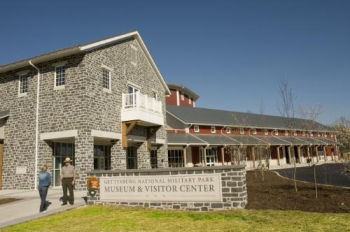Jul 21 2010
The Gettysburg National Military Park Museum and Visitor Center has achieved Gold certification in the U.S. Green Building Council's Leadership in Energy and Environmental Design (LEED®) Green Building Rating System™.
The LEED Green Building Rating System is the nationally accepted benchmark for the design, construction, and operation of high performance green buildings.
The Gettysburg National Military Park Museum and Visitor Center opened in 2008 and is operated by the Gettysburg Foundation in partnership with the National Park Service.
"Our certification at the Gold level highlights the Foundation's and the National Park Service's commitment to environmental responsibility and preservation," said Gettysburg Foundation Chairman Robert A. Kinsley. "When ground was broken for the facility back in 2005, we always had our sights set on achieving a certain level of environmental sustainability. We are thrilled that we have been able to exceed those goals as we work to preserve not only our past but also our future."
 Gettysburg National Military Park Museum and Visitor Center
Gettysburg National Military Park Museum and Visitor Center
The Gettysburg National Military Park Museum and Visitor Center is one of only four Gold certified LEED museum projects in the nation, and it is the first Gold certified museum project in Pennsylvania. LSC Design , Inc., of York, Pa., is the architect of record for the facility.
"Buildings are a prime example of how human systems integrate with natural systems," said Rick Fedrizzi, president, CEO and founding chair of the U.S. Green Building Council. "The Gettysburg National Military Park Museum and Visitor Center project efficiently uses our natural resources and makes an immediate, positive impact on our planet, which will tremendously benefit future generations."
Highlights of the Museum and Visitor Center's environmental responsibility include:
- Geothermal heating and cooling system: 207 wells, average depth of 550 feet use the earth's constant 55-degree temperature to heat and cool the facility
- Wetlands restoration: Nearly two acres of wetlands were restored during Museum and Visitor Center construction
- Native plants: Native, drought resistant plants that were used throughout the facility's campus require no irrigation
- Timber reuse: Existing timber was reused in the building's construction
- Recycling: A facility-wide recycling program was adopted
- Construction waste reduction: Metal, cardboard and wood was separated during construction to minimize waste
- Storm water run off minimization: Storm water run off was reduced through the use of underground storage tanks
- Plumbing: Low flow toilets and sinks were installed
- Reduced off-gasses: Off-gassing from carpets, glues, vinyl and paints was reduced
- Low-emission vehicles and carpooling: Parking spaces will be labeled for preferred use by hybrid vehicles and by carpoolers
- Green power: Green power credits will be purchased
- Regional materials: Twenty-five percent of the building materials manufactured locally, and 50 percent were harvested locally
Source: http://www.gettysburgfoundation.org/